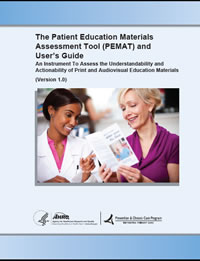
Please be aware that content on U.S. government websites is in transition due to President Trump's recent executive orders. We are attempting to download what we can before it disappears or is modified. If you encounter broken links or incomplete information on the linked websites, please let us know.
Assume all patients or clients may have
difficulty comprehending health
information and accessing health services
To help clinicians, the AHRQ has put together a Health Literacy Universal Precautions Toolkit.

Effectively communicating with your clients, patients, and the general public is a crucial part of improving their health and well being.
So what is Health Communication?
Plain language is clear communication that the general public can easily understand. The Agency for Healthcare Research and Quality (AHRQ) has a great page explaining the details about plain language.
Plain Language Basics




Use the tools below to help you figure out whether your handouts, displays, etc. use any language that might be hard for your audience to understand.
CDC Clear Communication Index


More Education about Plain Language



Plain Language Materials at Bellack Library
Children's books can be helpful in identifying easily understood language. Here are a few of the children's books we have in Bellack's collection.
Additional Books at Bellack about Plain Language
 Easy does it! plain language and clear verbal communication training manual
by
National Literacy Health Program, Canadian Public Health Association
Easy does it! plain language and clear verbal communication training manual
by
National Literacy Health Program, Canadian Public Health Association
Here are some documents that will help you learn and improve your own teach back practice.



Preparing the Content
Writing
Layout
Images
Readability
(Adapted from OSU College of Medicine's In Plain Words: Creating Easy to Read Handouts and Plain Language at AHRQ)
Corcoran, N. (2007). Theories and models in communication health messages. In N. Corcoran (Ed.) Communicaing health: Strategies for health promotion. Thousand Oaks, CA: Sage.